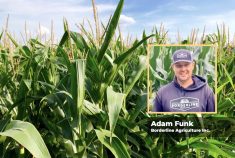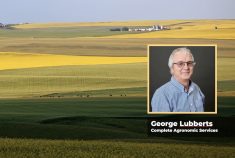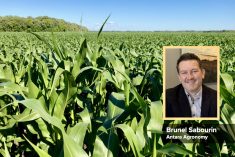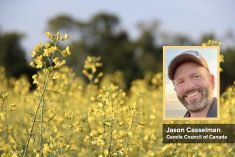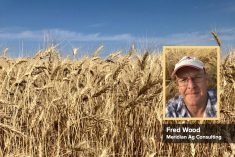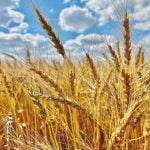When comparing current commodity prices against everything they have to pay for, including land values and rents, plus seed, fuel, chemicals and fertilizer, it’s no surprise that farmers want to maximize their soil’s performance. It’s enough to make double-cropping, especially after cereals, seem like an obvious choice — if only it wasn’t so risky.
Maybe in the extreme southwest of Ontario, the thinking goes, or perhaps in the U.S., but for the rest of us, it just isn’t realistic. To actually harvest enough beans to make it worthwhile, too many factors would have to line up too perfectly.
Read Also

Producers aren’t panicking over tariffs and trade threats
The influence of tariff and trade uncertainity on farm business decisions.
Well, maybe that’s changing. Today, double-cropping may actually be a little more forgiving thanks to new developments in plant breeding, including the release of early-maturing soybean varieties that are suited to Western Canada’s shorter growing season.
In other words, it may be possible to plant a western variety in the East in late June and still get a good stand.
At the very least, there are more farmers who are taking the double-crop plunge, and some have been doing it for quite a number of years.
Country Guide checked with two such farmers — Ian Matheson from Embro, Ont., and Mike Donnelly-Vander-loo from Thorndale. Each has his own preferences and rotations, but both have been double-cropping for years.
Ian Matheson — Embro
The Matheson name has become synonymous with double-cropping. His father Robert began working with it roughly 15 years ago, and since joining the farm following graduation from University of Guelph 11 years ago, Ian has continued the practice with brother Scott. The farm’s rotation follows a three- or four-year continuous corn schedule, followed by soybeans and then wheat or winter barley. It’s after winter barley that the Mathesons double crop their soybeans.
“It seems to have become a staple in our program any time following winter barley,” says Matheson, adding that the idea came from Eric Richter, sales agronomist with Syngenta. “In fact, I can’t remember harvesting winter barley without planting double-crop soybeans afterwards, and we’ve been constantly tweak-ing the program ever since, trying to increase our success rate.”
Again, this is considered more a practice for parts to the south and west. In the 1970s, growers in Kent and Essex could get a double crop in after peas or another processing vegetable crop, but everything had to be right, particularly the planting date and available moisture. That only happened once every five or seven years, if that. Yet Matheson now has no doubts about getting reasonable double-crop yields on a regular basis, thanks in large part to short-season varieties such as Syngenta’s S007-Y4s. Bred for the 00 and 000 regions in West-ern Canada, they could be a boon to double-crop opportunities in the East.
“Even in past years, where the experts have said it’s not likely to grow a harvestable crop, we’ve managed to get an 80 to 90 per cent success rate,” Matheson says. “It definitely works best in long, open seasons, but it’s not impossible in ‘backward’ seasons, either.”
Planting in late June or even early July, could be a limiting factor. If it’s going to be dry in midsummer, mid-July to early August will be the more likely window when precipitation is at a premium. To mitigate that, the Mathe-sons have tried applying liquid manure prior to planting in those dry years. But part of the challenge there is having to wait for the ground to dry before planting.
“It’s most important to plant into moisture, even if it’s deeper than would be considered acceptable in a full-season situation,” says Matheson. “With April-, May- or early-June-planted soybeans, there’s time to allow for the seeds to wait for a rain. But not in this instance: the ground is so warm, you can plant deep, find moisture and still get off to a good start.”
Not all farms are alike
It can’t be stressed enough that each farm is different, as is each farmer’s practices. This system and this rotation, on this land and with this climate all work together for the Mathesons. Their rotation means the double-crop soybeans precede the return to three or four years of corn. And it’s that first year’s corn that historically has been their best, even better than after straight barley. In the fall of 2015, they also tried aerial seeding of barley back into their double-crop soybeans just prior to leaf-drop. Late in the year, it didn’t appear to be a good catch of barley, but the family’s willing to leave it to the spring just to see if it’s possible to harvest four crops in two years.
Matheson says the primary driver was initially to keep the soil active and growing, instead of allowing it to sit idle for so much of the growing season. But then he began to wonder if there’s enough time to grow out a harvestable soybean crop, as well.
“I look at what can be spent on some of the current cover crop mixes out there, and we’re not spending all that much more for soybean seed, with what has the potential for a profitable harvest, as well as still having all the benefits of a cover crop,” explains Matheson. “We grew an oat-radish cover crop after wheat in 2015, and after seeing these short-day beans this year, we’re strongly considering trying a few acres of DC beans following wheat in 2016, if our wheat is harvested in July.”
In that sense, these soybean crops are much more than a cover crop. Matheson notes the double crop has its own set of management demands, but the soybeans are always planted with the full intention of harvesting them. That means planting and planning for success. He’s had other farmers tell him to cut back seeding rates to reduce the risk, but he’s found the population has to be kept fairly high for the best results, including maintaining inputs, not reducing them.

“With some of the things we’ve learned in the past few years, I’m positive that we can increase our chances even more for a profitable crop,” says Mathe-son. “We used to be happy if we had more than 25-bushel yields, but I think with the things we’ve learned, we can likely count on close to another 10 bushels on top of that in a comparable year.”
Mike Donnelly-Vanderloo
Double-cropping is naturally easier if the preceding crop comes off early, and for Mike Donnelly-Vanderloo, who farms east of London, Ont., near Thorndale, that base comes from their crops of processing peas.
In fact, on their farm, they have looked at a number of double-cropping options after the peas.
“Certainly we’ve tried soybeans, we’ve tried Roundup Ready soybeans, we’ve tried nattos, we’ve tried white beans, cranberries and black beans, and each one of them has its own pros and cons,” Donnelly-Vanderloo says. Now with the popularity of 00- and 000-zone soybeans, the options are increasing. “I can’t think of any other crop that’s pushing that northern frontier more than soybeans.”
Donnelly-Vanderloo also acknowledges that soybeans are probably easier to grow than white beans or cranberry beans, which face tight quality parameters and need a contract or a dedicated buyer.
“You have the quality issue, and that can weigh quite heavily on the decision,” Donnelly-Vanderloo adds. “It’s back to that risk versus reward, and often higher risks but also higher rewards. We have a little more leeway than most because we’re coming after processing peas, and that’s where we started about 20 years ago when we had vegetable contracts. We tended to go with the early peas because those helped us with a cash crop rotation of corn, wheat and soybeans, and we’re pretty heavy with edible beans like cranberries, kidneys and blacks and whites. So, peas were a nice fit because you could get them in early.”
How early?
One year, Donnelly-Vanderloo had to come back from vacation in early March because the ground was fit to plant his peas. The challenge with early peas, however, is that they’re a short-season, 60-day crop and if the rainfall doesn’t come, they can be still profitable, but it’s more of a challenge.
Two decades ago, double-cropping might have been more of an economic goal for Donnelly-Vanderloo to make money off the land while he could. Now, it’s come back full circle where the soil health issue becomes an important facet, along with the economic factor.
“Often, the peas can come off in late June, so now it’s not just the economics, it’s also keeping something growing, plus it’s the challenge of getting two crops in one year,” says Donnelly-Vanderloo. “The ultimate trifecta is if you can get the two crops and get a crop of winter wheat in. And we’ve done that a couple of years.”
That didn’t happen late in 2015, which was a bit of a disappointment given the length and warmth of the fall, but the peas came off a little later than expected, there was compaction requiring some field tillage, and then a rain event delayed planting.
Facing the decision to go with edible beans or soybeans or peas, it all comes down to the calendar and the available moisture, and the latter of the two is the more important factor with edible beans. Unlike soybeans, edibles can’t wait for moisture to come. They need to germinate fast. Available moisture is likely the factor that creates the most anxiety when it comes to double-cropping, particularly where germination is concerned.
Donnelly-Vanderloo was leaning towards white beans in 2015 but at the last minute, he decided to try soybeans. He began researching soybean varieties, first in Ontario but then started looking at available varieties suited to Manitoba. He found S007-Y4, which he calls “the James Bond variety” and it had done very well in 2014 in the West. So he contacted Eric Richter and asked about seed availability. As it turns out, the variety did well in Manitoba, so Richter asked Donnelly-Vanderloo if he’d be interested in growing the double crop for seed, including a premium.
“The germination was excellent, and everything was perfect for an extremely uniform seed set,” says Donnelly-Vander-loo with a smile. “So they’re going back to Manitoba for seed.”
He’s never had a double crop go for seed, but everything played out perfectly. If the soil was perfect and there had been no compaction from the pea combines (and that’s getting better now that four of the six machines he uses for harvest are tracked), they probably would have gone with cranberry beans.
Cranberry beans are the highest risk, but also carry the highest reward. Edible beans don’t have a large yield drag with later planting, unlike corn. If all systems are good and there’s sufficient moisture, significant yields are possible. Overall, Donnelly-Vanderloo states he can get a profitable double crop four out of five years.
“And only because we have peas, but if you’re talking to growers who are trying to do it after winter barley or — even more challenging — winter wheat, that’ll change the probability,” he says. “It’s a little easier for us, which isn’t to say that it’s going to work. We’ve been burnt too, and we don’t have it all figured out by any stretch of the imagination. And that’s just because we’re fortunate and we have some pea contracts. But there are some years where if it’s not going to click, we’ll just go with a cover crop and keep something growing in the soil.”
As with Matheson, Donnelly-Vander-loo’s double crop is more than just an elaborate cover crop: there is a goal of getting something marketable from that second planting. Plus it’s not as though he doesn’t plant cover crops. Every wheat acre he plants also gets underseeded with clover. Where that may change going forward is that he might start looking at cover crop blends. He’s also going to work towards reducing his plowing and tilling, although peas, he notes, are a different type of crop, with different challenges below the soil.
Donnelly-Vander-loo says he actually increases his fertility to continue driving yields. He’s also fielded some questions about seed costs, with suggestions that he drop his populations. But he keeps those higher to compensate for the later-season planting. He also acknowledges some concerns about pushing a winter wheat crop out of the rotation, in the hopes of driving higher yields from the double crop.
“If you go after the double crop and forgo that crop of winter wheat, you have to be careful,” says Donnelly-Vander-loo, adding that he’s had a few questions about how to increase his organic matter with such active soils. “And all I can say is that I didn’t get the winter wheat in (in 2015), but I did get bin-run wheat seed and put about 120 pounds or two bushels per acre. I put it on with a spinner-spreader and went out with a chisel plow, and in mid-December, you could see a little bit of green. So I’ll let that grow and I’m hoping that come spring, we’ll have maybe six inches, maybe 10 inches that I can burn off and seed into.”
Otherwise there’s a lost opportunity to plant that winter wheat crop with the potential for clover the following summer. But since Donnelly-Vanderloo is also a sweet corn grower, he has a little more flexibility to leave that broadcast wheat in a little longer if he wants.
This article was originally published in the February 2016 issue of the Soybean Guide




